
Soil Mechanics and Foundation Engineering
Scope & Guideline
Unlocking the Secrets of Soil Mechanics for Future Generations
Introduction
Aims and Scopes
- Soil Behavior and Properties:
Research exploring the mechanical properties and behavior of various soil types, including clay, sand, and expansive soils, under different loading and environmental conditions. - Foundation Design and Analysis:
Studies on the design, analysis, and performance of foundations, including shallow and deep foundations, pile foundations, and their interactions with soil. - Geotechnical Engineering Applications:
Application-oriented research focusing on real-world geotechnical problems, such as tunneling, slope stability, and underground construction. - Innovative Materials and Techniques:
Exploration of new materials, such as geosynthetics and nanomaterials, and innovative construction techniques that enhance soil stability and foundation performance. - Numerical and Experimental Methods:
Development and application of numerical modeling and experimental methodologies to simulate and analyze soil-structure interactions and foundation behavior. - Environmental Effects on Soil Mechanics:
Examination of how environmental factors, such as temperature, moisture, and pollution, affect soil properties and behavior.
Trending and Emerging
- Machine Learning and Data-Driven Approaches:
There is an increasing trend towards integrating machine learning and artificial intelligence techniques in predicting soil behavior and foundation performance, enhancing accuracy and efficiency. - Behavior of Expansive and Frozen Soils:
Research focusing on the unique challenges posed by expansive and frozen soils is gaining importance, particularly in cold regions and areas with significant seasonal changes. - Sustainable and Eco-Friendly Construction Practices:
A growing emphasis on sustainable practices in geotechnical engineering, including the use of recycled materials and environmentally friendly techniques, is emerging in recent publications. - Dynamic Analysis and Seismic Assessment:
The trend towards dynamic analysis, including the assessment of structures under seismic loading and the interaction between soil and structures during earthquakes, is becoming increasingly relevant. - Geotechnical Risk Management and Monitoring:
An emerging focus on risk management strategies and monitoring techniques in geotechnical engineering, particularly in urban environments, reflects the need for enhanced safety and reliability.
Declining or Waning
- Traditional Soil Testing Methods:
Research focusing on conventional soil testing methods has decreased as newer technologies and modeling techniques become more prevalent. - Static Analysis of Foundations:
The focus on purely static analysis of foundations has waned, with a growing emphasis on dynamic and time-dependent analyses reflecting real-world conditions. - Generalized Soil Models:
The use of overly simplified or generalized soil models is less common now, as there is a trend towards more complex, site-specific modeling approaches. - Soil Improvement Techniques:
Research on traditional soil improvement techniques is becoming less frequent, as innovative and sustainable alternatives are gaining traction. - Historical Studies in Soil Mechanics:
Papers focusing solely on historical perspectives or foundational theories of soil mechanics are less common, with a shift towards contemporary applications and innovations.
Similar Journals
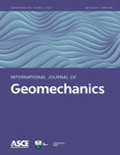
International Journal of Geomechanics
Elevating geotechnical engineering through impactful scholarship.The International Journal of Geomechanics, proudly published by the American Society of Civil Engineers (ASCE), stands as a pivotal cornerstone in the fields of geotechnical engineering, engineering geology, and soil science. With an esteemed Q1 ranking in both geotechnical engineering and soil science as of 2023, it represents a high-impact platform (impact factor information to be inferred as impressive given the rankings and prominence in the field). Since its inception in 2001, this journal has been committed to advancing the understanding of geomechanical processes, offering a vital forum for researchers, professionals, and students to disseminate innovative findings and practical applications. The journal is indexed by Scopus, holding an impressive position at rank #48 out of 229 in its disciplines, illustrating its significance and influence in the academic community. Although it does not currently offer open access, the journal continues to attract a diverse readership with its critical insights into soil behavior, earth structures, and various geotechnical challenges. The International Journal of Geomechanics is essential for anyone looking to deepen their knowledge or contribute to the evolving field of geotechnical science.

Soils and Rocks
Fostering Global Collaboration in Geotechnical ResearchSoils and Rocks is an academic journal dedicated to the field of Geotechnical Engineering and Engineering Geology, published by the Brazilian Association of Soil Mechanics and Geotechnical Engineering in collaboration with the Portuguese Geotechnical Society. Since becoming an Open Access platform in 2011, this journal has provided a vital publication outlet for researchers and professionals seeking to disseminate their findings on soil behavior, rock mechanics, and related topics within an international context. The journal is indexed in Scopus, holding a rank of 177 out of 229 in its category as of 2023, placing it in the 22nd percentile among its peers. Operating out of Brazil, Soils and Rocks encourages rigorous scholarly exchange and exploration of innovative practices within the sectors, making it an important resource for advancing knowledge in the geotechnical community. With a converged publication history from 2007 to 2024, the journal aims to foster significant advancements and insights that enhance our understanding of subsurface conditions and materials.

Acta Geotechnica Slovenica
Unveiling Insights into Geotechnical Challenges.Acta Geotechnica Slovenica is a distinguished peer-reviewed journal published by the University of Maribor, Slovenia, that focuses on the fields of geology, geophysics, and geotechnical engineering. With an ISSN of 1854-0171, it showcases significant research contributions that enhance our understanding of geotechnical challenges and innovations. The journal has been active since 2008 and has gained recognition within the academic community, holding a Q3 quartile ranking in Geology and a Q4 ranking in Geophysics and Geotechnical Engineering and Engineering Geology as per the 2023 categorization. Even though there are no Open Access options available, the journal remains an important resource for researchers, professionals, and students alike, serving as a platform for disseminating impactful findings in earth science disciplines. Its relevance is underscored by its rankings in Scopus, positioning it among the notable journals in its field. Engaging with Acta Geotechnica Slovenica offers an invaluable opportunity to stay at the forefront of geotechnical research and advancements.
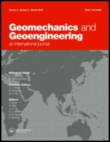
Geomechanics and Geoengineering-An International Journal
Connecting Academia and Industry in Geotechnical ExcellenceGeomechanics and Geoengineering-An International Journal, published by Taylor & Francis Ltd, serves as a prominent platform for the dissemination of innovative research and advancements in the fields of Geotechnical Engineering and Engineering Geology. With an ISSN of 1748-6025 and E-ISSN of 1748-6033, this journal has established itself as a critical resource within its category, ranking in the Q2 quartile according to the 2023 metrics and positioning itself in the top 38% of the Scopus rankings for Earth and Planetary Sciences. Geomechanics and Geoengineering encompasses a diverse range of topics, including but not limited to soil mechanics, foundation engineering, rock mechanics, and environmental geotechnics, ultimately aiming to advance both theoretical and practical knowledge in these vital areas. This journal not only highlights pioneering research but also facilitates a platform for academia and industry practitioners to collaborate and exchange ideas. While it does not offer open access, it remains a valuable resource for institutions and individuals committed to enhancing their expertise in the geotechnical domain. With convergence years spanning from 2006 to 2024, this journal is equipped to significantly contribute to the evolving landscape of geomechanical research.

Periodica Polytechnica-Civil Engineering
Championing Quality Research in Civil and Structural EngineeringPeriodica Polytechnica-Civil Engineering is a prestigious journal published by the Budapest University of Technology and Economics, dedicated to advancing the field of civil engineering through high-quality research and innovative practices. Established in 1972, the journal has transitioned through various phases of publication and now spans an expansive range of topics within civil and structural engineering, geotechnical engineering, and engineering geology. With an impact factor indicating its growing influence and a commendable placement in the Q3 quartile according to the latest 2023 metrics, it recognizes contributions that bridge theoretical advancements with practical applications. While currently not open access, the journal remains a vital resource for researchers, professionals, and students seeking to stay abreast of the latest developments in engineering design, construction techniques, and geotechnical innovations. The continuous publication of significant research after almost five decades underscores its commitment to disseminating knowledge crucial for the world’s infrastructure challenges, making it an essential reference point within the engineering community.
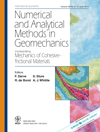
INTERNATIONAL JOURNAL FOR NUMERICAL AND ANALYTICAL METHODS IN GEOMECHANICS
Leading the Charge in Geomechanical Research AdvancementsWelcome to the International Journal for Numerical and Analytical Methods in Geomechanics, a prestigious publication dedicated to advancing the fields of geotechnical engineering and computational mechanics. Published by Wiley in the United Kingdom, this journal has been at the forefront of research since its inception in 1977 and continues to provide a vital platform for disseminating innovative methodologies and analytical approaches through 2024. With an impressive impact factor reflecting its excellence, the journal consistently ranks in the Q1 category across multiple domains, including Computational Mechanics, Geotechnical Engineering, and Engineering Geology, making it a key resource for specialists seeking to keep informed on important developments in these areas. Although it does not offer open access, the journal remains highly regarded among researchers and professionals for its rigorous peer-review process and commitment to scientific integrity. As a vital contributor to the field, International Journal for Numerical and Analytical Methods in Geomechanics invites researchers, professionals, and students to explore its comprehensive studies and to advance knowledge at the intersection of numerical analysis and geomechanics.

Teknik Dergi
Connecting Ideas, Inspiring Progress in EngineeringTeknik Dergi is a key academic journal published by the Turkish Chamber of Civil Engineers, focusing on the critical fields of Building and Construction as well as Civil and Structural Engineering. Established in Turkey, this journal serves as a vital platform for researchers, practitioners, and students to disseminate innovative findings and advancements within these disciplines. Although its coverage in databases like Scopus has been discontinued since 2022, Teknik Dergi remains a respected resource for its historical contributions, with a record of publication spanning from 1990 to 1998 and then from 2002 to 2022. The journal currently holds a Q4 categorization in both its primary fields, ranking within the 30th and 25th percentiles respectively. Authors and readers can access articles exploring practical applications and theoretical foundations, making it a valuable asset for those engaged in the rapidly evolving landscape of civil engineering. Open Access options are also available, allowing for broader dissemination and engagement with its published work.

JOURNAL OF GEOTECHNICAL AND GEOENVIRONMENTAL ENGINEERING
Championing Open Access Research for Global Engineering ChallengesThe JOURNAL OF GEOTECHNICAL AND GEOENVIRONMENTAL ENGINEERING, published by the ASCE-American Society of Civil Engineers, stands as a pivotal platform for disseminating innovative research in the fields of geotechnical and geoenvironmental engineering. With an impressive impact factor, this journal is ranked Q1 in both Environmental Science and Geotechnical Engineering and Engineering Geology, illustrating its prominence and significant contributions to the scientific community (Scopus Ranks: 38/229 and 48/233, respectively). The journal is dedicated to advancing knowledge and understanding of critical subjects such as soil behavior, environmental sustainability, and the interplay between geotechnics and environmental issues. Operating under the principle of open access, it ensures that vital research is accessible to a global audience, facilitating collaboration and innovation among researchers, professionals, and students alike. Since its inception in 1996, the journal has consistently evolved, with a commitment to maintaining high standards of scholarship and relevance in addressing contemporary challenges in civil and environmental engineering.
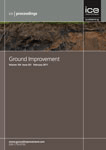
Proceedings of the Institution of Civil Engineers-Ground Improvement
Advancing Ground Improvement for Sustainable InfrastructureProceedings of the Institution of Civil Engineers-Ground Improvement is a distinguished journal published by EMERALD GROUP PUBLISHING LTD, dedicated to advancing knowledge and research in the fields of Building and Construction, Geotechnical Engineering, Mechanics of Materials, and Soil Science. With an ISSN of 1755-0750 and an E-ISSN of 1755-0769, this journal has been a vital platform for disseminating innovative research since its inception in 2008. With an impact factor placing it in the Q3 category across multiple engineering disciplines, it ranks favorably in Scopus, ensuring visibility and recognition among scholars globally. The journal offers open access options, allowing for broader dissemination of research findings. Targeting researchers, professionals, and students alike, it aims to foster discussions on ground improvement technologies and methodologies that are essential for sustainable infrastructure development. As it continues to converge its focus until 2024, the Proceedings stands as an imperative resource for those seeking to elevate their understanding and contribute to the ever-evolving field of civil engineering.
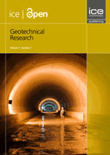
Geotechnical Research
Transforming challenges into solutions in geotechnical engineering.Geotechnical Research is an esteemed scholarly journal published by EMERALD GROUP PUBLISHING LTD, dedicated to advancing the field of geotechnical engineering and earth sciences. With an impact factor reflective of its robust contributions, this open access journal has been providing unrestricted access to high-quality research since 2014, making it indispensable for researchers, professionals, and students alike. The journal, indexed under the ISSN 2052-6156, features rigorous peer-reviewed articles that encompass a wide range of topics within geotechnical engineering and engineering geology, achieving a notable placement in the Q2 category in both Earth and Planetary Sciences and Geotechnical Engineering as of 2023. With its Scopus ranks further affirming its significance—ranked #44 out of 159 in Earth and Planetary Sciences and #78 out of 229 in Geotechnical Engineering—Geotechnical Research stands as a vital resource for innovative solutions and advancements in this critical field, ensuring researchers access to essential insights that drive the discipline forward.